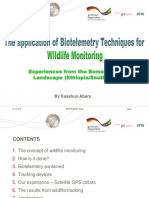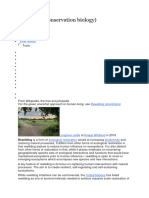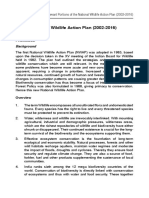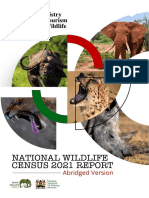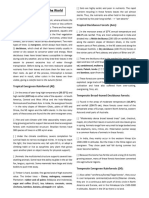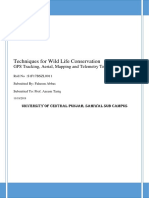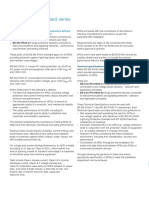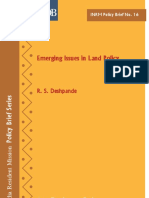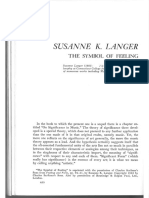SATELLITE WILDLIFE TRACKING USING THE ARGOS SYSTEM
Kevin Lay Sirtrack Ltd This paper is intended to provide researchers with the necessary information to determine the suitability of Argos satellite wildlife tracking as a research tool and initiate the ordering process. THE ARGOS SYSTEM The Argos environmental satellite system first flew in 1978 as a co-operative project between the French space agency CNES and US Government agencies NOAA and NASA. A parent company, CLS Argos, was formed to manage day-to-day systems operation and to provide customer (user) support. The Argos system currently consists of six polar orbiting satellites equipped with receivers centred at 401.650MHz. At relatively low altitudes of 740-850 km, these satellites have 5000 km visibility circles (footprints). During the satellite orbit, this footprint sweeps a wide swath around the earth, receiving signals from the satellite transmitters, known as Platform Transmitter Terminals (PTTs). The earths rotation shifts this swath 25 about the polar axis on each revolution with an overlap that increases with latitude. The number of daily passes over a PTT also increases with latitude. At the earths poles, a PTT would be within the visibility circle of the six satellites approximately 80 times per day, whereas at the equator, a PTT would only be visible perhaps only 20 times per day. Standard Argos processing uses data from three satellites. Locations from all six satellites are available when the Multi-Satellite Service option is specified to CLS Argos. All wildlife users should specify the Multi-Satellite Service. Argos locations are calculated by measuring the Doppler shift (frequency change), between PTT transmissions. The average duration of transmitter visibility by the satellite (pass duration) is 10 minutes. During this time a minimum of two PTT transmissions must be received by the satellite to enable a location to be calculated. ARGOS LOCATION CLASSES The class or accuracy of the location depends upon the following: Satellite/PTT geometry during satellite pass. Number of PTT messages received by the satellite during the pass. PTT frequency stability. PTT power output. Electromagnetic interference at the PTT location. Other considerations that effect accuracy of location are platform velocity and altitude. Both must be specified to CLS Argos at the time of application. Argos processing algorithms take the above factors into account to calculate the estimated accuracy of the location. This processing determines that 66% of the locations will be within the specified class. Class 3: Class 2: Class 1: Class 0: <150m accuracy. 150m < accuracy < 350m. 350m < accuracy < 1000m. Only available on request. This class provides good locations however, due to stability or plausibility checks being less than desired, no estimation of accuracy is given. Class A: 3 messages received but no estimation of location accuracy. Class B: 2 messages received but no estimation of location accuracy. Class Z: Rejected (messages received from PTT but no location can be calculated).
Sirtrack Limited Private Bag 1403 Goddard Lane Havelock North New Zealand Freephone 0800 SIRTRACK Telephone +64 6 877 7736 Fax +64 6 877 5422 Email sirtrack@sirtrack.com Website www.sirtrack.com
�DATA PROCESSING Two main ground-receiving stations provide global coverage by interrogating satellites once per orbit. Additionally, many smaller regional receiving stations receive data from satellites in real time whenever the satellite and PTT are simultaneously within station visibility. Following processing, locations and data can be accessed either by users on demand, or distributed by the Argos automatic distribution service (ADS). PLATFORM TRANSMITTER TERMINALS Platform Transmitter Terminals (PTTs) are highly stable UHF transmitters operating on 401.650MHz (+/- 30 KHz). The PTT transmit a complex data stream containing identification numbers, message format information and sensor data. This message is between 360 and 920ms long. A location only PTT requires a transmission length of 360ms whereas a PTT transmitting sensor data may require a transmission of up to 920ms. Each PTT has a unique identification number (ID number) that is issued by CLS Argos. Users must apply to CLS Argos to obtain ID numbers that are then forwarded to PTT manufacturers. REPETITION RATES PTT transmissions are repeated at set intervals, typically between 20 and 200 seconds. This is known as the repetition rate. Argos approves different repetition rates for particular applications. For example, a 30 second repetition rate is ideal for marine mammals that surface intermittently, but would not be suitable for ocean environmental buoys that are continuously on the surface and can use slow repetition rates of perhaps 90-200 seconds. Terrestrial animals and birds typically have repetition rates of 60-90 seconds.
Sirtrack KiwiSat PTTs have up to 24 duty cycles that can be programmed at time of manufacture. This means that the user can have the PTT turn on and off at different times during different parts of the deployment. For example, in a recent sea turtle study, the PTT had a duty cycle of 9 hours on / 3 hours off for 10 weeks. They then changed to 9 hours on / 51 hours off for four weeks, followed by 12 weeks of 9 hours on / 99 hours off. This enabled the researcher to follow the turtles intensively during the first part of the deployment and then change to less intensive monitoring at the end. The time of each duty cycle and the duty cycles themselves are totally flexible. ANTI-PASSIVATION SOFTWARE Lithium cells used by all PTT manufacturers are subject to a phenomenon known as passivation. Passivation is a buildup of salts on the anode of Lithium Thionyl Chloride cells. This occurs during the off part of the duty cycle when there is very low current drain. Long off periods can accentuate this problem. Passivation is more of a problem with partially discharged cells. This can mean that a PTT may not operate for its full life if it is deployed several times over a long period of time. Sirtrack have overcome the passivation problem by developing electronics to pulse the cells periodically during the off cycle. This ensures that the cells remain fresh. It is recommended that any PTT with an off period longer than 24 hours incorporate this free option. PTT CONFIGURATION AND PACKAGING PTT can be configured as collars, harness mounts or glue-on/tapeon backpacks. Packaging involves matching PTTs with suitable antennas and lithium cells and encasing them in waterproof polymers to ensure they can withstand the environment to be encountered. Our facility includes a 50-atmosphere pressure-testing chamber to test our packaging of PTTs for diving animals.
DUTY CYCLES PTTs can be put to sleep to save battery power and extend transmission life. When in this sleep mode, PTTs draw very little current, therefore a typical 1:1 duty cycle (say 6 hours on / 6 hours off), almost doubles the transmission life. Duty cycles are set during manufacture.
Sirtrack Limited Private Bag 1403 Goddard Lane Havelock North New Zealand Freephone 0800 SIRTRACK Telephone +64 6 877 7736 Fax +64 6 877 5422 Email sirtrack@sirtrack.com Website www.sirtrack.com
�GPS/ARGOS TRANSMITTERS Sirtrack produces GPS data-logging receivers that will soon be integrated with Argos transmitters to give more frequent and accurate transmitter locations. Due to size and power supply constraints, these packages are only suitable for deployment on larger mammals, such as wild dogs. VHF TRANSMITTERS PTT packages are often fitted with additional VHF transmitters to enable researchers to pinpoint animals for extra positional information and PTT recovery. VHF transmitters operate on separate lithium cells and can be incorporated into most PTT packages. MULTI SATELLITE SERVICE Argos offers a multi-satellite service option where PTT information from more than three satellites can be processed to provide additional locations. As of mid-2005, there are six satellites in the multiple satellite service, which can provide many more locations than the standard three-satellite service. Sirtrack recommends that all wildlife programs subscribe to the multi-satellite service. Contact your user office for further information. SYSTEM ENHANCEMENTS NOAA-K, launched in May 1998, carried the first of a new generation of Argos systems, called Argos-2, with increased receiver sensitivity and platform capacity. In addition to this, the new Argos2 systems operate over a wider bandwidth so low power PTT can be frequency separated from high power transmitters. NOAA K has now been joined by NOAA-L, NOAA-M and NOAA-N. The next generation will be the Argos-3 system satellites. These include down-link messaging enabling users to turn PTT on and off and control their parameters. Unfortunately, the hardware for this system is initially too large for most wildlife applications. Down-link messaging will not be available until around mid-2006.
SIRTRACK KIWISAT101 PTT Sirtrack manufactures 0.5W and 1.0W PTTs for use on terrestrial and marine wildlife. Following are the specifications of KiwiSat 101 PTT: Standard 0.5W output power or 1.0W output power option available with reduced transmission life. PTT measures 56mm long x 28mm wide x 12mm high. 42 days continuous operation on a single AA cell (90 Second Repetition Rate, 0.5W output power). Any number of cells can be used to produce custom designed packages and to extend transmission life. A two AA cell package (84 days life) measures 35mm wide x 20mm high x 130mm long (approx 100 g). A single AA cell package (42 days life) is 21mm wide at the front and 33 mm wide at the rear. The height is 20mm and the length 130mm (approx 70 g). The above solid cast hydrodynamic packages withstand at least 300 metres depth. Packages have been designed to suit individual applications up to 2000 metres depth. Can be duty cycled on and off and is available at any repetition rate approved by Argos. Our software includes multiple season duty cycles a PTT can have up to 24 seasons of different duty-cycles that enable researchers to adjust data collection at different times of the deployment. Supplied as standard with a Salt Water Switch (SWS) if required. The SWS will disable transmissions when the PTT is underwater and will initiate a transmission as soon as the PTT breaks the surface. The digital value of the SWS is also transmitted to indicate if the PTT is wet or dry at the time of transmission. A Haul-out timer is available to save power by disabling transmissions if the PTT is out of the water for longer than a programmed time limit. Transmission is resumed when the PTT re-enters the water. The Haul-out time over the previous 24 hours can also be transmitted. (Haul-out Time counter option). Passivation is the term given to the build-up of salt crystals on the anode of lithium cells (it is these salt crystals that give lithium cells long storage lives). Passivation occurs when PTTs are off for long periods due to sea turtles spending a lot of time underwater or because of long off periods in duty cycles. Passivation affects PTTs from all manufacturers. Our engineers have developed a software program that forces a small current to flow periodically
Sirtrack Limited Private Bag 1403 Goddard Lane Havelock North New Zealand Freephone 0800 SIRTRACK Telephone +64 6 877 7736 Fax +64 6 877 5422 Email sirtrack@sirtrack.com Website www.sirtrack.com
�from the lithium cells. It does consume 8% of a cells power per annum, however this is a small price to pay to have the cells fresh and ready to deliver transmission power on surfacing. Other available options include temperature sensing (+/- 1C), activity sensing (doubles as a mortality sensor) and a surface time counter. The PTT is turned on and off via the brief application of a magnet. The magnet is not required to be taped in place. This eliminates the possibility of magnets moving and PTTs inadvertently operating. A Light Emitting Diode (LED) indicates if the PTT has been turned on or off. SIRTRACK KIWISAT 202 LIGHTWEIGHT PTT Sirtrack has developed a new range of satellite PTTs incorporating Wildlife Computers Cricket OEM module. This has given us a range of small lightweight PTTs suitable for medium sized birds and animals. To date we have successfully deployed these PTTs on collars tracking lynx kittens in the USA, koala in Australia, glue/taped-on units on Albatross, Sooty Shearwaters, Adelie and Little Penguins and even whale dart packages in conjunction with Dr. Nick Gales. The smallest package is a 32g single AA cell unit suitable for medium to large birds. It is a high power, 0.5W output PTT that will perform well in areas of heavy radio traffic and Electro-magnetic interference, where often 0.125W PTTs are unusable. The life of these 32g PTTs is 30 days continuous with a 90 second repetition rate, however a suitable duty cycle will extend this life. For example a 1:3 duty-cycle of 6 hours on /18 hours off will extend the life to 115 days. We can add extra cells to increase the life if required. A two AA cell package will weigh approximately 50g and have twice the lives quoted above. When the KiwiSat 202 PTT is incorporated with VHF in collars, the total weight is roughly 120g. The transmitters run for 12-14 months with a duty-cycle of 12 hours on per week. ORDERING PTTs AND STARTING YOUR ARGOS PROGRAMME In conjunction with Sirtrack, define your system requirements. The most suitable PTT, repetition rate and duty
cycle can then be determined. Contact Argos for a programme application form. Within several weeks you should receive programme approval and PTT ID numbers. This information will be required by Sirtrack to programme the PTT. You should also receive a technical file and Argos purchase order or service agreement. Order your PTTs from Sirtrack and specify any customised packaging requirements. Define your processing requirements in your technical file and Argos purchase order/service agreement. Allow three to four days for approval once you have declared your requirements to Argos. Sirtrack can assist with Technical file information. When you receive your PTTs, they should be tested for approximately 12 hours to confirm correct operation. Once correct location information is received from Argos you are ready to start your programme. SIRTRACK PACKAGING ORDERING PROCESS On receiving your order Sirtrack will forward an Order Acknowledgement to you. This will contain all the essential details of your order that you should check to ensure that we have fully understood your needs. This acknowledgement will also show the scheduled dispatch date. We usually dispatch via door-to-door courier companies that take care of Customs clearance procedures when necessary. We trust that you have found the above notes useful, however, should you require further information please do not hesitate to contact us. We look forward to being of service to you. ARGOS CONTACT INFORMATION: Australasia: guan@clsargos.com.au Asia: clssin@pacific.net.sg North America: useroffice@argosinc.com Rest of world: useroffice@cls.fr
Sirtrack Limited Private Bag 1403 Goddard Lane Havelock North New Zealand Freephone 0800 SIRTRACK Telephone +64 6 877 7736 Fax +64 6 877 5422 Email sirtrack@sirtrack.com Website www.sirtrack.com





